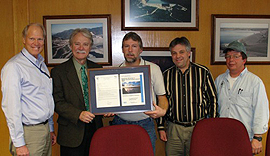Stabilizing agricultural production was critical to residents in Utah’s Sanpete
Valley in the early
1900s. Overdevelopment after the end of hostilities with Ute Indians in the
late 1860s stretched existing river resources beyond the limits of simple
irrigation. And although communities east of the Wasatch
Mountains had plenty of water, the
communities to the west, Ephraim and Spring
City, were not as
fortunate.
The Horseshoe Irrigation Co., which began operations in 1934, was
was one of the companies undertaking
efforts to manage and distribute water resources in the valley area. After a
number of mixed results to drill a tunnel through the mountain to move some of
that water from east to west, the company sought help from the Bureau of
Reclamation. Reclamation and the communities of Spring
City and Ephraim determined that a
system of small feeder canals and two tunnels would move water through the Wasatch Range to the communities. The canals would feed
water from Cottonwood Creek on the eastern side of the WasatchMountains into the Ephraim and Spring City
tunnels, which would operate independently. The water would then exit through
the tunnels into either Oak Creek for delivery
to Spring City or Ephraim Creek for delivery to Ephraim.
The Horseshoe Irrigation Co. agreed to enter into a
repayment contract with Reclamation for the Sanpete Project, signing the final
contract in May 1935. Reclamation oversaw the construction of the project,
which concluded in 1939. The Horseshoe Irrigation Co. managed the project’s Spring
City Division until it and Ephraim Irrigation Co., manager of the Ephraim
Division, met their financial obligations to the government. The Ephraim
Irrigation Co. made its final payment on its part of the project in 1979; Horseshoe
Irrigation, in 1980.
That’s why Horseshoe Irrigation Co. President Randy Strate minces no words when
he explains how he’s using the grant the company received from the Bureau of
Reclamation for its outstanding water-conservation efforts. “Many of our
diversion structures are old and in need of repair,” Strate said,” so we’d like
to upgrade as many of them as we can with more electronics and more accurate
diversion structures.”
Strate said that in 2007 the irrigation company received three Reclamation
grants: $12,385 for a water-use education program; $11,500 for completing a five-year
water-management plan; and $8,600 to install two flow-measurement meters.
These are only a few examples of how the Horseshoe Irrigation Co. has strived
to operate efficiently and work closely with Reclamation. It is also why Reclamation’s
Provo Area Office nominated Horseshoe Irrigation Co. to receive the Upper Colorado Regional
Director’s Outstanding Water Conservation Field Services Program
Accomplishment Award for 2007. Strate received that award in
November.
Strate sums up the reason for that cooperation simply. “It’s necessity,”
he said. “We have limited storage capacity, and we’re basically at the
mercy of Mother Nature. We have spring flows from creeks and depend on
secondary water but with low snow pack, conservation is a necessity.”
The Horseshoe Irrigation Co. was the first among Reclamation’s partners to
provide a water-conservation plan to Reclamation, something Reclamation
encourages water entities to develop and submit to the agency. It also
made great strides in water efficiency by installing ramp flumes, a weather
station, an electronic measuring and transmitting station to measure the tunnel
flow rates. And the company has encouraged more efficient use of agricultural
water by developing and implementing a program to replace sprinkler nozzles for
farmers.
But Strate is looking to future grants to help Horseshoe Irrigation Co. do even
more, starting with raising its profile. Additional grants will help to create
more shareholder awareness and to further some of the projects the company has
planned, he said. And he hints at a big project in the wings. “We have an
approximate 500-acre field system that we still flood irrigate,” Strate said, “and
that causes huge water losses, in part because it’s the one that’s furthest
away from our diversion points.” Consequently, the proverbial farmer at
the end of the ditch doesn’t get any water near the end of the water year because
what is left goes to more efficient sprinkler-irrigation systems.
“We want to fix that,” he said.



 Print Version
Print Version
 E-mail This Article
E-mail This Article
